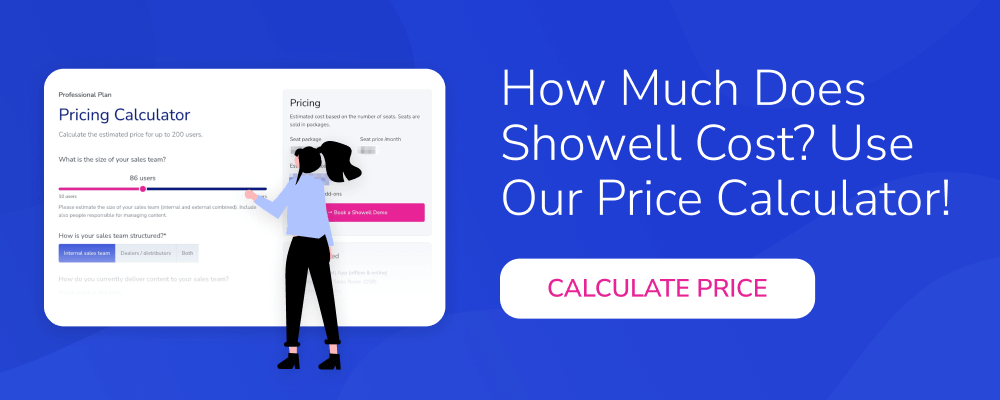Sales is an ever-evolving discipline. In a world where customer preferences shift like sand dunes and competition is fierce, a sales enablement plan is your compass and map.
In this article, we'll guide you through the Sales Enablement Plan creation process. Equip yourself with a keen mind and an eagerness to learn as we embark on this essential expedition to empower your sales force and bolster your business growth!
Table of contents:
- What is a Sales Enablement Plan?
- Why is a Sales Enablement Plan Important?
- Setting The Foundation of Your Sales Enablement Plan
- Building the Sales Enablement Toolbox
- Implementation and Communication
- Avoid These Common Pitfalls When Creating A Sales Enablement Plan
- Practical Examples and Sales Enablement Success Stories
What is a Sales Enablement Plan?
A sales enablement plan or sales enablement strategy is a well-designed plan that empowers your business of professionals with the information, resources, tools, guidance, content, and knowledge necessary to engage efficiently and effectively with prospects and clients–It aligns your teams with achieving common business goals.

This plan is not set in stone; it’s dynamic and evolves with market trends and customer preferences – but you need to have the plan to start from somewhere to maximize the impact of your efforts. The sales enablement approach and the strategy development might differ based on the organization, but the basic steps and key elements are more or less the same. In this article, we will cover all the key steps and elements to ensure the success of your sales enablement efforts.
Why is a Sales Enablement Plan Important?
Having a sales enablement plan or sales enablement strategy is critical for various reasons:
- Strategic Focus: A plan provides a clear direction and purpose for your sales enablement initiatives and helps in the execution. It outlines objectives and goals, ensuring that all efforts are aligned with the broader business strategy. Without a plan, you risk misaligned efforts or ad hoc initiatives that don’t support the long-term goals.
- Resource Allocation: A sales enablement plan helps in identifying what resources are needed and ensures that they are allocated effectively. This can include budget, tools, training materials, and personnel. Without a plan, your resources might be wasted or not used to their full potential.
- Accountability and Measurement: Having a structured plan allows for setting measurable sales enablement goals and KPIs. This enables you to track progress and hold teams accountable for their contributions. Without a plan, it's difficult to measure success or understand where improvements need to be made.
- Consistency and Standardization: A plan ensures that there is consistency in the sales enablement practices across your organization. This is crucial for scalability and ensuring that your sales reps, regardless of location or team, are equipped with the same level of knowledge and tools.
- Change Management: The sales environment can change rapidly due to market dynamics, competition, or internal changes. A plan enables you and your teams to better manage these changes, ensuring that there are processes in place to evaluate and adapt the sales enablement initiatives accordingly.
- Communication and Collaboration: A well-structured sales enablement plan facilitates communication and collaboration among various stakeholders, including sales, marketing, IT, and leadership teams. This ensures everyone is on the same page, and efforts are synergized.
- Long-Term Sustainability: A sales enablement plan is essential for sustainability. It ensures that best practices are documented and that there is a framework for ongoing development and improvement. This is important for maintaining a competitive edge and adapting to future challenges.
- Risk Mitigation: Having a structured plan allows for the identification of potential risks or obstacles in advance and the creation of mitigation strategies. This proactivity can prevent setbacks and ensure that sales enablement efforts are not derailed by unforeseen challenges.
- Employee Engagement and Morale: A clear plan provides you and your teams with a sense of purpose and direction. Understanding the bigger picture and how their role contributes to organizational success can lead to increased engagement and morale among the teams.
Setting The Foundation of Your Sales Enablement Plan
Before you set foot in the forest, you need to build a sturdy base camp.

Identify Key Internal Stakeholders and Get Them Involved
Key stakeholders, such as sales, marketing, and IT teams, play an instrumental role in crafting and executing an effective plan. You cannot get every single person in your organization actively involved, but it's crucial to have all relevant departments' support.
|
💡 Pro tip: Build a preliminary business case for sales enablement and discuss it with your leadership team to get everybody's buy-in. For example, Amazon uses these 1 and 6-pagers to build business cases, share their ideas, and for enhanced decision-making. Our team in Showell can also help you to start the conversation and provide you with the relevant information and materials needed. |
Define Business and Team Requirements
Pinpointing the business and team requirements ensures that the plan you devise is specifically tailored to your organizational needs. It also helps to prioritize the sales enablement goals, roadmap, milestones, and efforts later.
- Define Buyer Journey and Touchpoints: Understanding your buyer's journey is key to sales enablement requirements–eventually, sales enablement is all about buyer enablement. Break down the journey into stages and identify the touchpoints where you interact with the customer. Consider the current stage and evaluate the opportunities to improve.
- Evaluate the Current Sales Process: Conduct an analysis of your existing sales process and evaluate it against the buyer journey. Assess its strengths and weaknesses and identify any barriers that might impede sales efficiency.
- Determine Necessary Skills and Tools: Next, take stock of the skills and tools at your sales team's disposal. Identify which skills are lacking and what tools and systems are needed to improve performance in different stages of the buyer journey and sales process. Evaluate existing tech stack and define requirements for further system implementation.
- Build Documentation About All Requirements: Documenting the requirements provides clarity and a reference point for the sales enablement initiatives. It facilitates communication between different departments and ensures that everyone is on the same page.
|
💡 Pro tip: Talk to different department leaders and managers about their needs and map the requirements. By facilitating the discussions on requirements, you also start building ownership, and accountability and reduce change resistance when different people get involved already in the early stages. |
Prioritize, Set Clear Objectives, Roadmap, Milestones, and KPIs
Effectively structuring a sales enablement plan necessitates prioritizing initiatives, setting lucid objectives, a roadmap, and establishing.
- Establish a Hierarchy of Initiatives: With an array of potential sales enablement initiatives, it’s vital to create a hierarchy based on their impact and feasibility. Concentrate first on the actions that will directly contribute to achieving better results, and progressively tackle supplementary efforts.
- Formulate Objectives: Define sales enablement objectives that are Specific, Measurable, Achievable, Relevant, and Time-bound (SMART) that are Specific, Measurable, Achievable, Relevant, and Time-bound (SMART). This ensures that your goals are well-defined and can be realistically achieved within a specified timeframe while staying aligned with the overall business strategy.
- Create a Time-Bound Plan: Draft a roadmap that outlines the steps needed to achieve your sales enablement objectives. Assign timeframes to each initiative, ensuring that the schedule is realistic and aligned with the resources available.
- Define Measurable Milestones: Identify milestones, which are critical achievements or checkpoints along the way. These should be specific and measurable and should serve as indicators of progress. Milestones keep the team focused and provide opportunities for celebrating achievements, which can be motivational.
- Identify Relevant KPIs: Select KPIs that accurately reflect the progress towards your objectives. These can include metrics like implementation progress readiness, sales and marketing team eNPS, lead conversion rates, average deal size, or sales cycle length. Understanding the six key sales enablement KPIs is crucial for measuring success and making data-driven decisions. Monitoring these KPIs will enable you to evaluate the effectiveness of your sales enablement plan and make necessary adjustments.
|
💡 Grasping the importance of clear communication can foster an environment of trust, boost team morale, and ensure alignment with organizational objectives. Learn How to Successfully Communicate Sales Targets to Your Team → |
Establishing Ownership and Accountability
Assigning roles and responsibilities in sales enablement is like giving everyone in the orchestra their sheet music. Ensuring the success of your sales enablement plan requires a clear assignment of ownership and fostering a culture of accountability within the team.
- Assign Roles and Responsibilities: Clearly define the roles and responsibilities of each member involved in the sales enablement initiatives. Specify who is responsible for what, and make sure this information is communicated effectively throughout the team.
- Set Expectations: Outline the expectations for each role, including the goals and milestones they are responsible for and the standards they are expected to meet. Clearly defined expectations set a benchmark for performance and drive individuals to fulfill their roles.
By establishing ownership and accountability, you ensure that every member of the different teams is aligned with the sales enablement and actively engaged in contributing to its success. This not only maximizes efficiency but also fosters a culture of commitment and responsibility.
Building the Sales Enablement Toolbox
Empower your sales team by creating a robust sales enablement toolbox. This involves providing them with the necessary resources, tools, and training. Here's how to structure it effectively.
- Identify Your Target Audience and Ideal Customer Profiles (ICP): Develop precise buyer personas to understand the needs and challenges of your ideal customers. This involves profiling demographics, behavior patterns, motivations, and goals.
- Develop High-Impact Sales Enablement Content: Create sales enablement content that resonates with your target audiences, such as sales pitches, case studies, whitepapers, and product demos. This content should address pain points and showcase the value of your product or service.

- Implement Training Programs: Establish sales training curriculum and ongoing training programs to enhance sales techniques, product knowledge, and soft skills. Regular training keeps the sales team up to date and improves their ability to engage with prospects.
-
Utilize Technology: Adopt tools that streamline the sales process. Use CRM systems for managing relationships, analytics tools for insights, and sales enablement platforms for efficient sales execution. Ensure that these tools can be integrated for maximum efficiency.
- Leverage Automation and Cut Unproductive Tasks: Implement automation where possible to optimize repetitive tasks like email follow-ups, allowing the sales team to focus on high-value activities. Use technologies like Showell to cut off unproductive back-office tasks.
In summary, building an effective sales enablement toolbox involves combining sharp audience insights, impactful content, continuous training, and leveraging technology. This empowers the sales team to engage with prospects more efficiently and drive better results. Keep the toolbox dynamic – continuously evaluate and update it to align with the evolving market and customer needs.
Implementation and Communication
Once you’ve built your sales enablement toolbox and have a well-crafted plan in place, the next critical step is effective implementation and communication. This phase is where the rubber meets the road. Here’s how to ensure your sales enablement plan gets off the ground successfully.
Rolling Out Your Plan
Starting the implementation requires a well-orchestrated rollout. This should be done in phases. For example, you might begin by rolling out new training programs, followed by the introduction of new tools and content.
Consider a soft launch with a smaller group before going company-wide. This approach, often used in software development, allows you to gather feedback and make necessary adjustments.
Continuous Communication
Communication is key. Maintain open channels of communication with your sales team. Regular updates, newsletters, or meetings can be effective in keeping the team informed. For instance, Atlassian uses "Confluence" as a central hub for company communication and documentation. Engaging with Atlassian consultants can help you maximize the potential of Confluence and other Atlassian tools, ensuring seamless communication and collaboration across your sales team.
Cross-Functional Collaboration
Sales don’t operate in isolation. Foster collaboration between sales, marketing, product, and other departments. Regular inter-departmental meetings or shared project management tools like Trello or Asana can be helpful.
Provide Support and Resources
As the plan rolls out, ensure that your sales team has the support and resources they need to adapt to new processes and tools. This might include tutorials, FAQs, or a help desk.
Collect Feedback
Create a system for collecting feedback from your sales team. They are on the front lines and may offer valuable insights into what’s working and what isn’t. Tools like Google Forms or SurveyMonkey can be effective for this purpose. You can also use SurveyMonkey alternatives if you need more advanced features.
Monitor and Adjust
Finally, keep a close eye on the KPIs you’ve established. If something isn’t working as well as you hoped, don’t be afraid to make adjustments. Have regular intervals with key stakeholders to evaluate the progress and make adjustments.
Celebrate Wins
It’s also important to celebrate successes, even small ones. This can boost morale and foster a sense of accomplishment and belonging among the team.
Implementing your sales enablement plan is not a set-it-and-forget-it endeavor. It requires continuous communication, cross-functional collaboration, support, feedback collection, monitoring, and adjustment to ensure that your sales team is well-equipped and aligned with the goals and objectives of the plan.
Avoid These Common Pitfalls When Creating A Sales Enablement Plan
By understanding and avoiding these traps, you can streamline your journey toward a successful sales enablement strategy.
1. Overloading Sales Teams with Information
It’s tempting to provide your sales team with an abundance of resources, but this can lead to information overload. The cognitive burden can impede performance. Instead, curate and organize content so that it’s easily digestible and accessible.
2. Neglecting Continuous Training
Assuming that initial training is sufficient is a common mistake. Sales is a dynamic field, and your team needs continuous training to stay ahead. Hosting engaging sales training workshops and incorporating regular webinars should be a staple.
3. Not Aligning With Sales and Marketing
Sales and marketing are two sides of the same coin. Failure to align these teams can create disconnects in messaging and objectives. Regular communication and shared goals are essential. For example, many organizations encourage collaboration between their sales and marketing departments through shared KPIs and joint campaigns.

4. Ignoring Feedback from Sales Representatives
Not listening to the feedback from your sales representatives is like ignoring the canary in a coal mine. Sales reps are on the front lines and can offer valuable insights. Establish channels for feedback and ensure that it is acted upon.
5. Failing to Adapt to Market Changes
The market is not static, and clinging to an outdated sales enablement plan can be detrimental. Regularly review your strategy in light of new market trends, competitor movements, and customer preferences.
6. Setting Unrealistic KPIs
Setting KPIs that are unrealistic or misaligned with your business objectives is like chasing a mirage. Your KPIs should be Specific, Measurable, Achievable, Relevant, and Time-bound (SMART). Regularly reassess them to ensure they remain aligned with your objectives.
7. Relying Too Heavily on Tools
While tools and technology are essential, relying too heavily on them at the expense of human judgment and relationships is a pitfall. Remember, at the heart of sales is human interaction.
8. Not Monitoring ROI
Failing to monitor the ROI of your sales enablement initiatives is akin to sailing without a compass. Use analytics to monitor ROI and ensure that your initiatives are delivering value.
Avoiding these common pitfalls requires a vigilant, adaptive, and integrated approach to sales enablement. Keep your ear to the ground, foster collaboration, continuously train your team, listen to feedback, and regularly assess and realign your KPIs and tools. This vigilance will serve as your North Star, guiding you through the tempestuous waters of sales enablement towards the haven of success.
Practical Examples and Sales Enablement Success Stories
As the adage goes, “A single example is worth more than a thousand words in an argument.” After walking through the intricacies of creating a sales enablement plan, it's time to turn our attention to the real world.
In this section, we will look at some inspiring customer success stories. These practical examples serve not just as validation but also as a wellspring of insights that you can draw upon while formulating your own sales enablement strategies.

Let’s dive in and explore how these companies transformed their sales operations and achieved remarkable results through the effective implementation of sales enablement.
Gaggenau: How Gaggenau Uses Sales Enablement App to Stay on Top of Other Brands
Founded in 1683, Gaggenau stands as a global pioneer in the luxury appliance industry, boasting its headquarters in Germany and a network of distributors across the globe. Presently, it operates as a subsidiary of Bosch-Siemens Hausgeräte (BSH Hausgeräte). Gaggenau is renowned for melding classic aesthetics with top-tier functionality, all underpinned by extraordinary partisanship.
Read more about Gaggenaus Sales Enablement Success Story →
Sandvik: How Sandvik is Making it Easy for Their Global Dealers to Sell
Sandvik, headquartered in Sweden and listed on the Stockholm Stock Exchange (STO), is an international engineering conglomerate with a focus on mining and construction equipment. The company boasts a presence in 160 nations and employs approximately 40,000 people. Sandvik uses Showell with their dealers worldwide.
Read more about Sandviks Sales Enablement Success Story →
Ponsse: How Ponsse Improved Dealer Sales Through Product Training
Ponsse holds a distinguished position as a leading manufacturer of cut-to-length forestry machinery on a global scale. With operations extending to more than 40 countries, Ponsse is dedicated to supporting its clientele in attaining success by providing reliable, high-performance machines and services. The company is publicly traded on the Nasdaq OMX Nordic exchange.
Read more about Ponsses Sales Enablement Success Story →
Britelite: How Britelite Saved Hundreds of Hours and Enhanced Sales Performance
Britelite, a leading UK provider of doors, windows, conservatories, and flat roofing solutions, has a team of 75 Showell users, including sales reps, marketing, and operations personnel. To overcome challenges in their sales process, they turned to Showell for help. As a forward-thinking company, Britelite always seeks ways to improve its sales process and grow its business.
Read more about Britelites Sales Enablement Success Story →
Conclusion
In conclusion, a well-designed Sales Enablement Plan is essential for empowering different departments and teams. It provides a strategic framework that aligns efforts, optimizes resources, and fosters accountability. By setting clear objectives, establishing ownership, and building a robust sales enablement toolbox, businesses can equip their sales professionals with the necessary tools and knowledge to engage effectively with prospects and clients.
💡 Learn next:
Start building your Sales Enablement Plan today and unlock the full potential of your sales team. Book a demo with our sales enablement expert below. We will guide you during your journey toward sales excellence.





